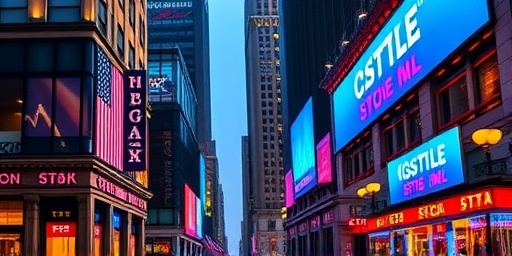In a resounding vote of confidence from Wall Street, the US Stock market surged to unprecedented heights on Friday, with the Dow Jones Industrial Average and the S&P 500 both closing at record levels. This milestone comes amid heightened expectations for sweeping tax cuts under the incoming administration, fueling investor optimism even as inflation remains a stubborn headwind for the economy.
The Dow Jones climbed 1.2% to surpass 45,000 points for the first time, while the S&P 500 gained 1.5%, pushing past 6,000 and marking its seventh consecutive weekly advance. Trading volume spiked as retail and institutional investors piled into equities, betting on pro-business policies that could supercharge corporate profits and consumer spending.
Dow Jones and S&P 500 Break Barriers Amid Frenzied Trading
The Dow Jones, a bellwether for blue-chip stocks, led the charge with a blistering rally that saw it add over 500 points in the final trading hour. Iconic components like Apple, Boeing, and Goldman Sachs propelled the index upward, with Apple’s shares jumping 2.8% on reports of favorable regulatory shifts. Analysts attribute this surge to the Stock market‘s sensitivity to policy signals, where even preliminary whispers of tax cuts can ignite multi-billion-dollar buying sprees.
Meanwhile, the S&P 500’s broad-based gains reflected strength across sectors, from technology to financials. The index, which tracks 500 of the largest US companies, benefited from a 3.1% leap in the Nasdaq Composite, underscoring the tech-heavy market’s resilience. ‘This isn’t just a blip; it’s a structural shift driven by expectations of lower corporate taxes,’ said Michael Thompson, chief market strategist at Vanguard Investments. ‘The S&P 500’s earnings yield is now competitive with bonds, drawing in yield-hungry investors.’
Key statistics from the session highlight the intensity: The CBOE Volatility Index (VIX), often called Wall Street’s ‘fear gauge,’ plummeted to 12.5, its lowest in months, signaling calm amid the storm. Over $4 trillion in market value was added across major indices, per preliminary data from Bloomberg. This performance caps a year where the Stock market has returned nearly 28% year-to-date, outpacing global peers and defying earlier recession fears.
Tax Cuts Take Center Stage in Investor Sentiment
At the heart of Friday’s exuberance are anticipations for tax cuts that could echo the 2017 Tax Cuts and Jobs Act, which slashed the corporate rate from 35% to 21%. With the new administration set to take office in January, policymakers have floated ideas for further reductions, potentially to 15%, alongside extensions for individual deductions. Investors are pricing in these reforms, viewing them as a catalyst for the economy’s next growth phase.
‘Tax cuts under the incoming team could add $2 trillion to GDP over the next decade,’ projected economist Laura Chen of the Peterson Institute for International Economics in a recent report. Her analysis, based on fiscal modeling, suggests that lower taxes would boost disposable income, spurring consumer-driven sectors like retail and housing. Wall Street heavyweights agree: JPMorgan Chase CEO Jamie Dimon noted in a CNBC interview, ‘We’re seeing a risk-on environment precisely because of these policy tailwinds. The stock market is forward-looking, and it’s betting big on tax relief.’
Yet, not all views are unanimously bullish. Some economists warn that aggressive tax cuts could balloon the federal deficit, already at $35 trillion, exacerbating long-term pressures on the economy. Still, the immediate reaction in the stock market has been overwhelmingly positive, with exchange-traded funds (ETFs) tracking small-cap stocks—like the Russell 2000—surging 2.4%, as these firms stand to gain most from simplified tax codes.
To illustrate the breadth of impact, consider the following sectors poised for gains:
- Financials: Banks like Citigroup rose 1.8%, anticipating higher lending activity from economic stimulus.
- Energy: ExxonMobil gained 1.1% on expectations of deregulation alongside tax breaks.
- Consumer Discretionary: Amazon and Tesla led with 2.5% and 3.2% increases, respectively, as shoppers’ wallets thicken.
Inflation Lingers as a Shadow Over Market Euphoria
Despite the stock market’s triumph, inflation concerns refuse to fade into the background. The Consumer Price Index (CPI) rose 3.2% year-over-year in November, per the latest Bureau of Labor Statistics data, keeping the Federal Reserve on alert for potential rate adjustments. Core inflation, excluding food and energy, ticked up to 4.1%, signaling persistent price pressures in services and housing.
Investors are threading a needle: betting on tax cuts to juice the economy while hoping the Fed won’t hike rates aggressively in response. ‘The stock market is climbing a wall of worry,’ quipped Sarah Patel, portfolio manager at BlackRock. ‘Inflation at these levels erodes real returns, but the allure of tax-driven growth is overpowering that narrative for now.’ Federal Reserve Chair Jerome Powell, in a speech earlier this week, emphasized a data-dependent approach, noting that ‘while progress has been made, the economy isn’t out of the woods yet.’
Historical parallels offer context. During the 2017 tax overhaul, the S&P 500 rallied 19% in the following year, even as inflation hovered around 2.5%. Today’s environment, with inflation double that rate, adds complexity. Bond yields reflected this tension, with the 10-year Treasury note climbing to 4.3%, pressuring growth stocks but bolstering bank profits.
Market participants are also eyeing upcoming economic indicators, such as December’s jobs report and the Fed’s December meeting minutes, which could sway the trajectory. A softer-than-expected inflation print next week might sustain the rally, while hotter numbers could prompt profit-taking in the Dow Jones and S&P 500.
Sector Spotlights: Tech and Finance Drive the Surge
Friday’s action wasn’t uniform; certain sectors stole the show, amplifying the overall stock market gains. Technology, long the engine of US equities, posted a 2.2% sector increase, led by semiconductor giants like Nvidia and Advanced Micro Devices. Nvidia’s stock soared 4.1% to $145 per share, buoyed by AI demand and potential tax incentives for R&D investments.
Financials followed closely, up 1.9%, as banks position for a lower-tax regime that could enhance net interest margins. Berkshire Hathaway’s Class B shares, a Dow component, advanced 1.6%, with Warren Buffett’s conglomerate seen as a safe haven in volatile times. Conversely, utilities lagged with a modest 0.5% gain, as investors rotate out of defensive plays into cyclical bets tied to economic expansion.
International implications are noteworthy too. European markets, including the FTSE 100 and DAX, rose in sympathy, up 0.8% and 1.1% respectively, on hopes that US tax cuts could spill over via trade. Asian indices like the Nikkei 225 opened higher on Monday, reflecting global interconnectedness.
Retail investor participation hit record levels, with apps like Robinhood reporting a 40% uptick in trades. ‘The democratization of the stock market is accelerating this bull run,’ observed fintech analyst Raj Singh. Data from the NYSE shows individual accounts now represent 25% of trading volume, up from 15% pre-pandemic.
Outlook: Policy Pivots and Economic Horizons Ahead
Looking forward, the stock market’s trajectory hinges on the speed and scope of tax cuts, alongside the Federal Reserve’s inflation playbook. If Congress passes reforms by mid-2025, analysts forecast the S&P 500 could reach 6,500 by year-end, implying another 8% upside. However, geopolitical risks, such as ongoing trade tensions, could cap gains.
The economy itself shows mixed signals: GDP growth accelerated to 2.8% in Q3, per Commerce Department figures, with unemployment steady at 4.1%. Consumer confidence, as measured by the Conference Board, surged to 110.5 in December, the highest since 2022, driven by wage gains and policy optimism.
Experts urge caution: ‘Tax cuts are a powerful elixir, but without fiscal discipline, they could fuel inflation further,’ warns Brookings Institution fellow David Wilcox. Investors are advised to diversify, with balanced portfolios incorporating bonds and commodities to hedge against volatility in the Dow Jones and broader market.
As the new year dawns, Wall Street’s eyes are on Capitol Hill. The interplay of tax policy and monetary strategy will define whether this surge evolves into a sustained boom or encounters headwinds. For now, the record highs stand as a testament to the enduring allure of American economic promise.









